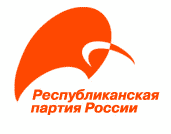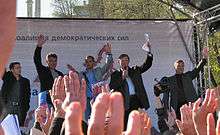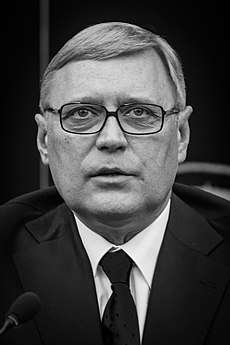People's Freedom Party
People's Freedom Party Партия народной свободы | |
|---|---|
 | |
| President | Mikhail Kasyanov |
| Merger of | People's Freedom Party, United People's Party of Soldiers' Mothers, Peasant Party of Russia, Forward, Russia! |
| Headquarters | Moscow, Russia |
| Youth wing |
Youth committee of Solidarnost People's Democratic Union of Youth |
| Membership (2011) | 46,158 |
| Ideology |
Federalism Liberal democracy Economic liberalism Liberal conservatism Pro-Europeanism Anti-communism |
| Political position | Centre to Centre-right |
| European affiliation | Alliance of Liberals and Democrats for Europe Party (associate) |
| International affiliation | None |
| Colours | Dark violet |
| Slogan | "For Russia, with free will and without corruption"[1] |
| Seats in the State Duma |
0 / 450 [2] |
| Seats in the Regional Parliaments |
1 / 3,980 |
| Website | |
| parnasparty.ru | |
The People's Freedom Party (Russian: Партия народной свободы, Partiya narodnoy svobody), or PARNAS (Russian: ПАРНАС),[3] is a Russian liberal democratic political party.
The Republican Party of Russia (RPR) is one of Russia’s oldest political parties. In 2007 the party was denied re-registration and declared to be dissolved by the Russian Supreme Court. It was only after the European Court of Human Rights ruled that the denial of registration was unlawful that it could restore its official registration in May 2012. Today, PARNAS is led by Mikhail Kasyanov and is an associate member of the Alliance of Liberals and Democrats for Europe (ALDE).[4]
History
Formation (1990)
The Republican Party of the Russian Federation was founded in 1990 by members of the Democratic Platform of the CPSU, who had become disillusioned with the party's unwillingness to reform. The foundation of the new party took place in November 1990. Nikolay Lysenko, Stepan Sulakshin and Vyacheslav Shostakovsky were elected as the three co-chairman. The Republican Party joined the Democratic Russia bloc, an umbrella organisation of pro-democracy movements. The Republican Party was close to the Social Democratic Party of Russia, that was founded earlier in 1990. The two parties shared similar program and there were attempts to merge. The Republican Party's program has been characterised as liberal and pragmatic; similarly to the Social Democratic Party, however, the Republican Party had internal factions: ranging from social democracy to social liberal to liberal conservative.
Early developments (1991–2007)

The RPR and the SDP formed a united faction (Объединенная депутатская группа РПРФ/СДПР) in the Russian Congress of People's Deputies (later, they fused with similar groups to form the faction 'Left Centre', which was pro-reform but more moderate than groups like the 'Radical Democrats', which advocated radical economic reforms). In contrast to the social democrats, the Republicans participated in the Movement of Democratic Reforms that was formed in summer, 1991 and included mostly liberal-minded former nomeklatura members (Alexander Yakovlev, Gavriil Popov et al.). The Republican Party initially supported both Yegor Gaidar's economic reforms and Boris Yeltsin in his conflict with the Supreme Soviet; later, some of the leaders turned more critical of Yeltsin. The Republican Party left the Democratic Russia bloc in October, 1993 due to disagreements with the bloc's policies.
The party members won altogether 12 seats in the newly elected parliament in 1993: 5 republicans within the Yabloko bloc and 7 from Democratic Choice of Russia. In the 1995 legislative election, party ran within the Pamfilova — Gurev — N.Lysenko bloc, that failed to cross the 5% barrier. Lysenko and Ella Pamfilova won seat through majoritarian district.
At the end of 1998, Nikolay Lysenko, retaining the post of RP chairman, joined Yuri Luzhkov's Otechestvo bloc, whereas a number of the regional organisations of the Republican Party cooperated with small liberal parties like Right Cause or Sergey Kiriyenko's New Force etc.
In 1999, Lysenko won a parliament seat in a majoritarian district. In 2002, the party was reorganized into the Republican Party of Russia.[5]
Dissolution and reestablishment (2007–2011)

| Wikimedia Commons has media related to Case of Republican Party of Russia. |
In 2007, the Russian Supreme Court ruled the party to be dissolved, according to Ryzhkov because of the opposition to the government. In 2011 the European Court of Human Rights ruled out the refusal to register the party was unlawful. Since 5 May 2012, the Justice Ministry has restored the state registration of the Republican Party of Russia.
In 2006–2010, the RPR was a member of coalition "The Other Russia". Since 2010 it is a member of the liberal coalition "For Russia without Lawlessness and Corruption" and a member of non-registered People's Freedom Party based on this coalition. People's Freedom Party will continue to work on the base of Republican Party and it may be renamed.
In 2011, party's dissolution was held to be unlawful by the European Court of Human Rights.[6] In January 2012, following the entry into force of the ECtHR’s judgment, the Supreme Court of the Russian Federation quashed its 2007 decision to dissolve the party.[7]
Merger and recent elections (2011–present)
The Ministry of Justice recognized the merger of the Republican Party and the People's Freedom Party (RPR–PARNAS) on 2 August 2012, after the European Court of Human Rights ruled that the party should be restored in May of that year, and it supported the 2011–13 Russian protests, although since then the party has been mostly on the decline in influence among opposition circles.[8][9]
In 2012 the RPR-PARNAS participated in regional elections in Barnaul (1 seat), Saratov Oblast, Tuva (2 seats).
Democratic Coalition and 2016 elections
In July 2015, the party congress voted to shorten the party's name to just People's Freedom Party (PARNAS).[10] In April 2015 a number of opposition parties formed a unified Democratic Coalition to take part in the 2016 legislative election, as well as the 2015 regional elections as a test. This included PARNAS, as well as Progress Party of Alexei Navalny, the Democratic Choice party of Vladimir Milov, as well as several others. The unregistered movements needed to band with PARNAS as they were rejected from the right to take part in elections as the necessary signatures they collected were deemed invalid, while PARNAS was officially registered as Boris Nemtsov held a seat in the Yaroslavl Oblast Duma. In 2015, the coalition focused on four regions where their candidates were accepted by the Central Election Commission—Novosibirsk, Kaluga, Kostroma, and Magadan.[11] They were only able to run in the Kostroma region in the end, where they scored 2.28% of the vote, not enough to obtain a seat in the regional legislature.[12]
However, the primary that was held to create the candidates list that would run for the coalition in the elections ended up breaking down, for multiple reasons. One of the main ones was the publication of a sex tape involving Mikhail Kasyanov and another PARNAS member, at which point Alexei Navalny and Ilya Yashin wanted Kasyanov to take part in the primaries himself also rather than automatically be on the candidate list (Kasyanov's position on the party ticket was part of the agreement in forming the coalition). Members of the "December 5" party proposed to hold a vote to decide whether the reserved spots on the party ticket should exist or not, and while the others supported the idea, PARNAS vetoed it.[13] When he refused to do so they pulled their support, effectively ending the coalition. PARNAS went on to hold a primary but it was disrupted when hackers posted the personal information of voters who took part in it online. The candidate leading in the primary was Vyacheslav Maltsev, whose views were described as ultranationalistic, but the hacked information revealed that many of the voting accounts had the same passwords, suggesting that someone had been using bots to inflate the votes of select candidates. Kasyanov refused to step down after the debacle and stood in the 2016 elections,[14] in which he gained 0.7% of the vote and not a single seat in the 7th State Duma.[15]
2017 Moscow municipal election
During the Moscow municipal election, 2017, PARNAS partnered with the liberal party Yabloko in a coalition called 'United Democrats' to get candidates elected to local councils of deputies in municipal districts of Moscow. Specifically, PARNAS only gained two out of 1,502 seats up for election, but the coalition as a whole obtained over 260 seats.[16]
2018 presidential election
In October 2017, Kasyanov proposed that the liberal opposition candidates intending to run for the presidency in 2018—including Grigory Yavlinsky, Alexei Navalny, and Kseniya Sobchak—form a coalition and field a single candidate in order to increase their chances.[17][18] In early December PARNAS revealed that this coalition was never formed and announced that they supported the three opposition candidates, so the party did not have any of its own candidates run for the presidency.[19]
Ideology
The ideology of the RPR-PARNAS is liberalism, federalism and human rights. In his interview, Kasyanov said "there is no higher value for the government than human rights." He defined ideological stance of PRP-PARNAS as right-of-center liberalism.[20]
Among the main principles of the PARNAS party program are securing the individual rights of Russian citizens and equality of all before law, and that the government should be democratic, controlled by the public and should serve the interest of the people. The party condemns the Bolsheviks who seized power in 1917 and the existence of the Soviet Union, which it considers tyrannical, and models itself after the Constitutional Democratic Party that existed during the late Russian Empire. It also promises to declassify all KGB and other Soviet documents as part of a "decommunization" program and ban all promotion of the communist regime. For Russia's form of government it proposes to create a parliamentary republic and increase local self-governance. In addition, PARNAS wants to reform the judiciary to be truly independent, remove government control over the mass media, and promote small business and entrepreneurs over oligarchs.[21]
The party considers the 2014 Russian annexation of Crimea illegal and has vowed to return control of Crimea back to Ukraine, hence PARNAS did not campaign in Crimea in the 2016 Russian parliamentary elections.[22] According to its 2015 election platform, it stated that it wants Russia to become a partner of NATO and the European Union, as well as to end military interventions in other countries.[23]
Leaders
- Co-chairs
- Mikhail Kasyanov (since 2006)
- Vladimir Ryzhkov (2012-2014)
- Boris Nemtsov (2012 - until his assassination on 27 February 2015)
- Federal Political Council of RPR-PARNAS
Bureau:
- Mikhail Kasyanov
- Boris Nemtsov (until his assassination on 27 February 2015)
- Ilya Yashin (until 16 December 2016)
- Valentina Melnikova (former co-chair of the party)
- Sergey Aleksashenko
- Konstantin Merzlikin
- Vadim Prokhorov
- Alexander Berstenev
Others:
- Igor Stasovskiy
- Vladimir Vladimirovich Kara-Murza
- Vyacheslav Maltsev
See also
| Wikimedia Commons has media related to Republican Party of Russia – People's Freedom Party. |
References
- ↑ "В Москве прошел 15-й восстановительный и объединительный съезд Республиканской партии России — Партии народной свободы" (in Russian). Republican Party of Russia. June 16, 2012.
- ↑ http://www.vedomosti.ru/politics/news/5001251/rprparnas_proshla_v_gorodskuyu_dumu_barnaula
- ↑ "Two Russian parties merge in push against Putin". Reuters. Retrieved 4 March 2015.
- ↑ "Archived copy". Archived from the original on 2013-12-17. Retrieved 2013-12-10.
- ↑ http://www.panorama.ru/works/vybory/party/rprf.html
- ↑ "HUDOC Search Page". Retrieved 4 March 2015.
- ↑ ВС РФ отменил решение о ликвидации Республиканской партии России. http://rapsinews.ru
- ↑ RPR-PARNAS Republican Party of Russia - People's Freedom Party. Global Security. Retrieved 7 May 2017.
- ↑ Russia's opposition PARNAS party registered. Voice of Russia (now Sputnik News). Published 2 August 2012. Retrieved 7 May 2017.
- ↑ PARNAS congress votes to shorten party name and elect Kasyanov as leader. Alliance of Liberals and Democrats for Europe official website. Published 10 July 2015. Retrieved 7 May 2017.
- ↑ Milov, Vladimir (11 August 2015). Democratic Coalition: what next?. Free Russia Foundation. retrieved 6 May 2017.
- ↑ Russian opposition party PARNAS to vie for State Duma seats in coalitions with Navalny. TASS. Published 19 September 2015. Retrieved 7 May 2017.
- ↑ Associates Navalny said about the collapse of the coalition Kasyanov. FreeNews English. Published 27 April 2016. Retrieved 7 May 2017.
- ↑ The strange death of Russia's ‘Democratic Coalition’. Published 31 May 2016. Retrieved 7 May 2017.
- ↑ The Russian Democratic Opposition Has Become Completely Helpless. Middle East Media Research Institute. Published 2 January 2017. Retrieved 7 May 2017.
- ↑ United Democrats win over 260 seats in Moscow municipal assemblies – Gudkov. Johnson's Russia List. Published 11 September 2017. Retrieved 14 February 2018].
- ↑ ПАРНАС предложил Собчак, Навальному и Явлинскому создать предвыборную коалицию (in Russian). TASS. Published 30 October 2017. Retrieved 6 December 2017.
- ↑ Ex-PM Kasyanov urges coalition with other opposition figures, eyeing presidential polls RT. Published 31 October 2017. Retrieved 6 December 2017.
- ↑ Sukhov, Denis (16 December 2017). В ПАРНАС не видят смысла в выдвижении своего кандидата на президентские выборы 2018 года. Komsomolskaya Pravda. Retrieved 16 December 2017.
- ↑ "OnlineTV.ru — первое интерактивное телевидение". Retrieved 4 March 2015.
- ↑ За что мы боремся и к чему стремимся. Краткая программа ПАРНАС | What we are fighting for and trying to reach. Shortened program of PARNAS. PARNAS official website. Published 19 April 2017. Retrieved 7 May 2017.
- ↑ Russian Opposition Party Will Not Campaign In Annexed Crimea, Radio Free Europe (19 August 2016)
- ↑ Oppositionist Kasyanov heads up renamed PARNAS. Russia Beyond the Headlines. Published 5 July 2015. Retrieved 6 May 2017.
Sources
External links
- Official website

- St Petersburg branch of RPR-PARNAS
- The website of Vladimir Ryzhkov
- The 2011 website of the Republican Party (Internet Archive)
- About the party
- Articles
